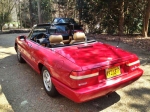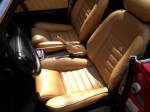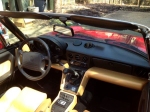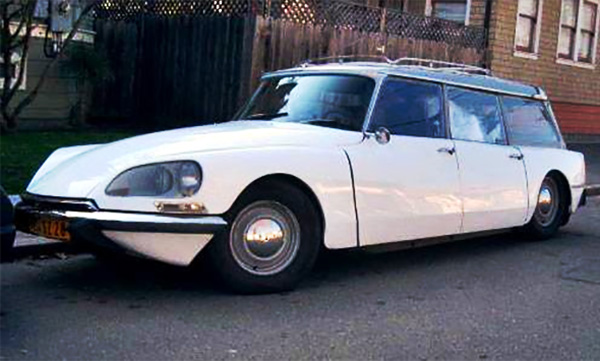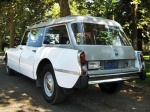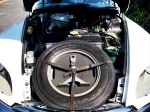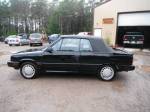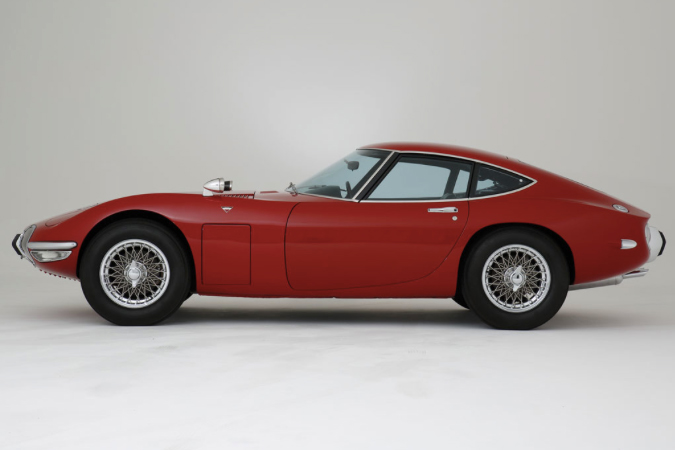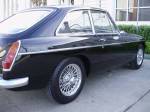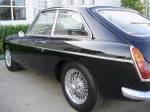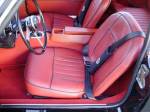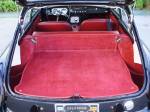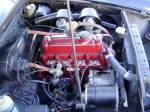Anyone who has spent any time in Eastern Europe will recognize the Trabant, which at one time was by far the most popular car there. These were the East German equivalent to the Volkswagen Beetle, philosophically anyway. They were basic transportation whose only criteria was to get from point A to point B and be relatively affordable for the average working family. As such they spread throughout the Eastern Bloc with demand far outnumbering supply, despite nearly three million built altogether. At the height of the Soviet era, the waiting list for a Trabant was as long as that of a Ferrari 458 today. Their bodies were made of a lightweight plastic similar to Formica, powered by a two-cylinder, two-stroke 600 cc motor. It was reliable and economical. It was an appliance. That said, weighing only a few hundred pounds more than a Triumph Bonneville with a similar engine, as well as a low center-of-gravity, four-wheel independent suspension and front wheel drive, some weren’t content with an appliance and made these quite capable weekend rally cars. The activity was popular enough to inspire Trabant to make a factory rally car near the end of production, with a bored-out 800cc motor and 5-speed transmission. Production of the Trabant ended shortly after the Wall came down. The West was adopting strict emission and safety standards while the East now had access to more modern cars. There are still some on the road today and those that remain have a rather passionate following. Several “Trabi” clubs exist worldwide, including in the US, where some have been imported and titled in states with less stringent emission standards. This 1980 Trabant P601 is US-legal with a Maryland title. It appears to be in good unrestored condition and has travelled only 55,000 km (~35K mi.). Paint is described as presentable with all original trim. Reliability was always one of the Trabi’s endearing qualities and what the two-stroke motor lacks in sheer horsepower, it makes up for in being very simple for even the least mechanically-inclined to work on, with parts available and help available through online community groups. It’s hard to say if we’ll ever see a Trabant 601 at a Bonham’s, Gooding or RM Auction, but there is enough nostalgia and fervor to keep interest, if not values, growing. Find it here on Craigslist in White Hall, MD for a very proletarian $3,500.
Category: All Cars (Page 6 of 14)
Over its 30-year production run, the Type 105 Alfa Romeo Spider captured the essence of La Dolce Vita as no other car before or since. Associated with Italian movie stars and a movie star in its own right—appearing in films like Under The Tuscan Sun, Wayne’s World, Fletch, and of course The Graduate—it was stylish, nimble, sporty, and radiated a spirit of carefree adventure. From the iconic boat-tailed Duetto to the Kammbacks to the more unified design of the final series, they remained more or less unchanged in their appearance, whilst engine choices ranged from the early cars’ twin-cam 1600 to the lively 2.o litre motors with Motronic injection used in the Series 4. These last Spiders, produced from 1990-1994 are the most refined, with wraparound taillights and body-colored bumpers and side moulding, along with the aforementioned Bosch EFI motors that significantly improved reliability and power band, making these the most drivable of the 105s. Even today, they feel as modern as an MX-5 Miata or late Model Honda S2000, yet retain that unmistakable, classical Alfasong exhaust note. While mid-generation Spiders are lingering in the $5-10,000 range, these Series 4s have been escalating and are second only to the Duettos for collectibility. Certainly there are many that were bought for enjoyment and have well over 50,000 miles. This was also the only 105 Spider to offer automatic transmission, so there are some decent examples that can be found in that price range. Guideline examples, with under 50,000 miles, solid history and proper originality, are getting harder to find for under $15K. This 1991 Alfa Romeo Spider looks to be mostly original, with only an aftermarket CD player straying from its factory spec. While not original, the new top and upholstery are factory correct, giving it a fresh appearance without too many points deducted. It is said to have been extremely well-maintained throughout its life, which has seen just under 40,000 miles. For about the same money as a second-hand Miata with similar miles, it’s an investment-quality classic Italian roadster that’s amoré. Find it here on Craigslist in Richmond VA for an attractive $12,000.
From the beginning, the emphasis of the Buick Riviera was on styling, which further dictated how the car was to feel and drive. In the ‘60s, there was the knife-edged coupé, which in 1965 finally got the iconic clamshell headlamps as Styling Director Bill Mitchell had intended from inception. The late ‘60s saw a Riviera that was maturing, perhaps not as distinctive, but still very stylish. Then, in the early ‘70s, there was the Boattail. It was at once futuristic and retrospective, with a nod to the vee-shaped fastback design of the mid-year Corvettes, with other cues owing to Bugatti and Aston-Martin. And while far from a sports car like these, there was an almost celestial confluence of sportiness, elegance and muscle. It came at the end of an era, before the fuel crisis, when bigger was better in Detroit. And it was big—over two tons—yet the curves and proportions work so well that it seemingly needs that much mass to pull it off. Power came from a 455 cubic-inch V8 putting out 255 hp; not bad for an emissions-choked car from the early ‘70s, but it needed every bit of that. Behind the wheel, there is no doubt that something very big is at work under the hood, but there is also a sense that it could easily do more, as evidenced by Pontiac’s High Output and Super Duty 455s of the same time that were producing well over 300 hp. That said, while there was muscle under the food, the Boattail Riviera, as those that came before it, was about personal luxury. To that end, it had plush seats, power everything and a pillowy ride. Inside the car, there was little to distinguish it from Cadillac’s Eldorado, although the Buick’s split-window-like rear glass gave it more of an airy feel. Furthermore, the rear-drive layout of the Riviera gave it more of a cockpit environment over the Eldo, with the driveshaft tunnel creating some separation. As collectibility goes, there does seem to be some quiet interest in ‘71-‘73 Boattails. They have seen slow but steady growth over the last few years, despite a soft economy. Compared to the coveted ‘65s, which peaked at around $60K, then fell sharply and haven’t recovered, the Boattails are a relatively safe bet. Subsequent generations increasingly became variations of a GM platform and were eventually ubiquitous to any other G Model, at least until the final series in the late ‘90s with their jelly-bean styling. This is an excellent original 1973 Riviera that has had a single family owner, covering only 68,000 miles. It is said to have been routinely maintained and the condition of the paint and interior are indeed evidence that it has been lovingly cared for throughout its history, including a recent service. Chrome, glass and trim appear to be equally nice and fit is surprisingly good for a big ‘70s two-door out of Detroit. It looks especially good in white over saddle, evoking a sort of refined bad-assness, not unlike the glam rock of that era. It’s not hard to imagine the two going together. Find it here on Craigslist in Dublin CA for a very reasonable $8,800.
When it was introduced in 1955, what the Citroën DS lacked in performance, with its motor dating back to the 30s, it certainly made up for in innovation. To begin with, the teardrop shape designed for optimal aerodynamics and comfort was like nothing else on the road and it remains one of the most distinctive cars ever made. It was also the first car to use a hydropneumatic suspension, making the car literally float over road imperfections whilst allowing the car to lower and raise to as high as 10 inches. The hydraulic system was also used to operate the power front disc brakes, also an industry first as well as power steering. Furthermore, its unique mid-engine front-wheel-drive layout provided excellent traction without much compromise to balance. This was further aided by a wider track at the rear that all but eliminated typical front-drive understeer. With the launch of the DS21, its 2175 cc fuel-injected motor (one of the first European marques to feature fuel injection) provided ample power to make it a fine boulevard cruiser, if not a competent touring car. Combined with its suspension, the improved motor was the basis for some successful rallying including the Rallye Monte Carlo. Perhaps its greatest notoriety came when Charle De Gaulle’s DS21 Limousine outran Algerian gunmen… on two flat tires. In wagon (Safari) form, its cavernous cargo area was equally presidential. In fact, in its native France and other parts of the world, it was recruited for ambulance, paddy wagon and other commercial duty. Today, whether in 4-door saloon or 5-door Safari form, they turn heads not only for their uniqueness, but that to even those unfamiliar with the specifics, they just look like they were ahead of their time in so many ways. While we in the US were regulated to sealed beams and were slighted of the way-ahead-of-its-time directional headlamps, driving a DS21 in good nick feels in some ways like we still haven’t caught up. Unfortunately, like so many cars with hyropneumatic systems, it was also the DS’s achilles heel. Replacing the system, at least until recently, has been more work and expense than the cars were worth. Unlike other suspension only systems, the DS’s controlled brakes and steering as well, making it a very pricey undertaking. However, a spike in the rare Chapron-built convertibles to near six-figure prices has lifted all DS and even the downscale ID prices. In recent years, DSs have begun to get rescued, straightened out, or restored. Today’s example is a 1969 DS21 Safari that is a long-time California car and appears to be original, straight and rust-free. In addition, the spheres and accumulator, which are at the heart of the hydro-pneumatic system, are said to be in excellent shape. With only 82,000 original miles, this could be kept in a high driver condition or with some relatively minor sorting could be something more investment grade and the seller has it priced accordingly, with a No. 3 fetching low teens whereas a No. 1 car can bring just shy of $30K. This one’s in the middle here on Hemmings in Stillwater MN for $19,000.
Let’s start by acknowledging that to anyone who has followed cars for some time, the Renault Alliance doesn’t come up on anyone’s ten-best list. Even hardcore Renault enthusiasts (both of them?) would probably lean toward it being more of a crap car. That said, the same company who brought us the Alpines and the outrageous R5 Turbo—not to mention Formula 1 champions then and now—took a page from the BMW M3 and Mercedes Cosworth and tuned their little people’s car with engine mods, tighter suspension, bigger wheels and a few aero refinements. This was the Alliance GTA of 1987 and 1988. Perhaps because it was crap to begin with, the transformation—vis à vis the Bimmer and Merc—was astonishing. In what must’ve seemed like a road test no staffer took seriously, the Alliance GTA was not only quicker through Road & Track’s 700-ft slalom than the aforementioned cars, but the Corvette and Alfa GTV6 as well, just to name a few. In fact, its skidpad number of .89g would still put it among the top twenty cars ever tested. Somehow, Renault’s motorsport savvy brushed off. Furthermore, they were significantly cheaper than the Bimmer or Merc—cars that have become collector and enthusiast darlings—and yet today, they’re off the map, rarely to be seen. Perhaps because of their lower price, they’ve been neglected or have reached some other demise. In any case, here’s one. And it’s one with less than 58,000 original miles. And it’s a convertible. And it’s less than $2,000. Compare that to a $40,000 E30 M3 or a $15,000 190 2.3 16V or even a $5,000 MK2 GTI, neither of which were offered in a convertible—or at least not in 1987. Yes, according to the listing, it could use a bit of sorting out, but it will clean up well and will undoubtedly offer a lot of bang for the buck, just as it did in 1987. Find it here on Craigslist in Soo Locks MI for only $1,750.
A new limited edition LMX version of the Audi R8 will not only be the most powerful roadgoing iteration of the super sports car ever made, but will also be notable as the first production car to adopt laser high beam lighting as standard. The new 570PS, 198mph R8 LMX will make its UK public debut at the Goodwood Festival of Speed and will become available to order at the same time priced from £160,025 OTR. UK deliveries will begin in the autumn.
The Audi R8 LMX is based on the acclaimed V10 plus model with its high-revving, mid‑mounted ten-cylinder engine, double wishbone suspension and ASF (Audi Space Frame) aluminium body. It will be available exclusively as a coupe with a production run limited to 99 vehicles, and with 540 Nm of torque to complement its 570PS output will be capable of rocketing to 62mph from rest in just 3.4 seconds before topping out at 198mph.
A compact, seven-speed S tronic transmission transfers the power to the quattro permanent all-wheel drive system, which distributes it judiciously to racing-inspired 19-inch, 20-spoke wheels shod with tyres with 215mm front and 305mm rear widths. These conceal carbon-fibre ceramic brake discs with red anodised calipers measuring 380 mm in diameter at the front.
The light emitted by laser beams before they pass through a phosphor converter is blue, and this has inspired an Audi exclusive Ara Blue, crystal effect customised paint finish for the new R8 LMX. If preferred, it can also be ordered with Daytona Grey matt effect or Mythos Black, metallic paint finishes.
The new flagship model is also marked out by a large, fixed rear spoiler for increased downforce on the rear axle, and by additional use of carbon fibre-reinforced polymer (CFRP) for the front spoiler lip, side flics, engine compartment cover, exterior mirror housings, sideblades, rear wing and diffuser. The Singleframe grille and front air intakes and the outlet grille at the rear are finished in titanium grey, while the sports exhaust system features high-gloss black tailpipes.
Blue accents continue the theme in the interior with its bucket seats upholstered in Fine Nappa leather and finished with Sepang Blue diamond stitching and backrest covers in Ara Blue. Sepang Blue diamond stitching also adds contrast in the Alcantara headlining and black Fine Nappa leather door trim panels, and the colour is also sewn into the edges of the parking brake lever, centre tunnel console, steering wheel and instrument cowl.
The list of subtle details marking out this exclusive model also includes matt carbon covers for the centre tunnel console and parking brake lever, the inlays in the doors and the arc around the cockpit, and illuminated aluminium inlays bearing the limited-edition number integrated into the CFRP door sill trims. Fine Nappa leather adorns the selector lever for the S tronic and the knee pads, and the floor mats have black piping and Sepang Blue stitching.
Revolutionary laser high beam lighting
In 2008, the Audi R8 became the first production car in the world to feature all‑LED headlights; this was followed in 2012 by dynamic indicators with a unique sweeping action. Audi launched a new chapter in automotive lighting with the Matrix LED headlights, which debuted in the updated A8 in 2013. Now the brand with the four rings is progressing to the next stage in the R8 LMX: the laser spot for the high beams. It increases the illumination range substantially, which is ideal for a supercar like the R8 LMX.
Audi engineers work very closely with their racing colleagues on the development of lighting technologies. The combination of LED and laser high beams, for example, will be used for the first time on the new Audi R18 e‑tron quattro at the 24 Hours of Le Mans on June 14 and 15. The premium brand is thus continuing its tradition of using racing to test new technologies destined for production.
“Audi has long dominated the most important 24-hour race. In addition to the outstanding TDI drive technology, a maximum light yield gives our pilots a major advantage, and with night racing in particular is a key factor to our success,” says Prof. Dr. Ulrich Hackenberg. “The transfer of the laser headlight to the Audi R8 LMX underscores our leading position in lighting technology. The safety benefit this provides to the customer truly represents Vorsprung durch Technik,” says AUDI AG’s Board Member for Development.
With the new laser high beams, one laser module per headlight generates a cone of light with twice the range of the all-LED headlight. Each module comprises four high-power laser diodes. With a diameter of just 300 micrometers, these generate a blue laser beam with a wavelength of 450 nanometers. A phosphor converter transforms this into roadworthy white light with a colour temperature of 5,500 Kelvin – ideal conditions for the human eye that enable the driver to recognise contrast more easily and help prevent fatigue. The laser spot, which is active at speeds of 37mph and above, supplements the LED high beam in the R8 LMX and greatly enhances visibility and safety. An intelligent camera-based sensor system detects other road users and actively adjusts the light pattern to avoid dazzle.
LOT 131 – Aston Martin DB2/4 Coupé
Without Reserve – €150,000 – €200,000 [moto+match estimate: €200,000]
The DB2/4 was introduced in October 1953, and it provided a lot more room over its predecessor. This was accomplished in part by raising the roofline slightly over the DB2 and reducing the fuel tank capacity by two gallons to add to rear seat room. Other notable changes included a wraparound rear windscreen, larger front and rear bumpers, and the addition of a hatchback, which is believed to be the first fitted to a production car. 140 bhp, 2,922 cc DOHC six-cylinder engine, four-speed manual transmission, independent front suspension, live rear axle with parallel arms and coil springs, and four-wheel drum brakes. Wheelbase: 2,510 mm
- Chassis no. LML/980
- Engine no. B6A/50/147
- A splendid example of Aston Martin’s gentleman’s tourer
- Includes Aston Martin Heritage Trust Certificate and factory build sheet
- Less than 300 miles accumulated since restoration
Lot 133 – 1968 Toyota 2000GT
€545,000 – €620,000 [moto+match estimate: €650,000]
Chassis MF10-10174 was produced on 19 January 1968, finished in Pegasus White, and delivered new to its home market of Japan as a right-hand drive model. This 2000GT, being offered today from its native country, has recently completed a restoration, where it was repainted in a striking shade of burgundy and fitted with chrome Borrani wire wheels. The brilliant paint colour is beautifully accented by the chrome details on the car, and it attractively showcases the design features of this stunning sports car. Surly this would be a wonderful example to drive and enjoy, as it showcases Toyota’s brilliant European-inspired design. The 2000GT is a hugely important car in the history of the automobile. Without the 2000GT, there might not have been a Honda NSX or a Nissan 240Z, and the industry on the whole might have looked very different from what it is today. The 2000GT shattered the preconceived notions of what the world thought a Japanese car could be, and it changed the automobile industry for the better. Collectors have finally come to realise the importance of these wonderful little sports cars, and they have become quite desirable in recent years. This 2000GT oozes a sporting elegance that is wonderfully stated by its dark red paint and Borrani wire wheels, which work to accentuate its brilliant design. It would be a wonderful example to drive and enjoy. 150 bhp, 2,000 cc Yamaha DOHC hemi-head inline six-cylinder engine, triple Solex twin-choke side-draft carburettors, five-speed fully synchromesh manual transmission, four-wheel independent suspension, and four-wheel power-assisted Dunlop disc brakes. Wheelbase: 2,329 mm
- Chassis no. MF10-10174
- Beautifully restored in dark red with chrome Borrani wire wheels
- Japan’s iconic sport’s car

Lot 165 – 1956 Porsche 356 A Carrera 1500 GS/GT Speedster by Reutter
€780,000 – €900,000 [moto+match estimate €900,000]
- Chassis no. 82189
- Engine no. 90638
- Original matching-numbers Carrera engine
- Rare combination of Carrera GS and GT trim levels
- Copy of original Kardex warranty card
- Desirable Rudge wheels
- Ideal for Porsche club events and vintage rallies
Lot 166 – 1969 De Tomaso Mangusta
€160,000 – €210,000 [moto+match estimate €250,000]
The Mangusta offered here was beautifully restored for its present owner with painstaking attention to detail, and it is likely amongst the finest examples in existence. It is freshly completed and has been refinished in what is believed to be its original factory colours, a dazzling green (simply called Lime, found below a later colour change to red) over black leather upholstery, which is a combination that is oh-so-appropriate for a sports car produced at the wild end of the Swinging Sixties. Unlike many of these cars, which have been hot-rodded over the years, this example has always been preserved in very much its original specification, which is something that the owner held true to during its restoration. The early 289 V-8 and ZF1 transmission, which is the same as was used in the GT40, were fully rebuilt, and care was taken to restore all components in their original finish. The car retains the original sand-cast wheels, with their slightly rough texture, and dials lettered in Italian, suggesting that this Mangusta may have originally been a European-delivery example. Importantly, the car retains its very rare original jack and tool roll, as well as the remote-starter button under the bonnet, allowing a mechanic to turn over the engine during maintenance. This Mangusta is currently domiciled in the UK, and it will be sold with its V5C registration and recent MOT test certificate. It is interesting to note that mangusta translates to “mongoose”, which is one of the few natural enemies of the cobra. The name is indicative of the performance to which the ferocious Mangusta aspired and which this beautifully restored example can undoubtedly achieve. 271 bhp, 289 cu. in. overhead-valve Ford V-8 engine, five-speed ZF manual transmission, unequal length tubular wishbone front suspension with coil springs and anti-roll bar, wide-base unequal length wishbone rear suspension with trailing arms, coil springs, and anti-roll bar, and four-wheel power-assisted Girling disc brakes. Wheelbase: 2,500 mm
- Chassis No. 8MA890
- A beautiful, muscular icon of the 1960s
- The most desirable quad-light, early-production iteration
- Equipped with the high-performance Ford 289 V-8
- Freshly restored in its stunning original colour
- Offered with its original jack and rare tool set
Lot 189 – 1973 Fiat 130 Coupé by Pininfarina
Without Reserve €10,000 – €15,000 [moto+match estimate €18,000]
- Chassis no. 130BC 0002020
- Long-term ownership by Francesco Stanguellini
- Fewer than 32,000 kilometres from new
- On display for many years in the Stanguellini Museum
London, 29th April 2014; Trident, the British sports car brand, today announced the global availability of its flagship Iceni sports car, the world’s fastest & most fuel efficient diesel sports car.
With a top speed in excess of over 190mph and the ability to run for 2000 miles on a single tank of mineral or bio-diesel, the Iceni uses torque multiplication technology to achieve this unique combination of speed, power & fuel efficiency.
Two new models to the Iceni range are also unveiled today, the Iceni Magna (fastback) & Iceni Venturer (estate). All three models boast the same impressive spec, each with its own distinctive design. In addition, the cars can store a minimum of two suitcases, as well as two holdalls, making a 2000-mile road trip a reality.
Phil Bevan, designer & founder of Trident said, “The Trident cars deliver incredible speed & performance combined with outstanding fuel efficiency, achieved through our unique torque multiplication technology.”
It is widely believed that horsepower delivers power, speed & fuel efficiency, but it is in fact torque that matters. Using this technology in a road car increases fuel efficiency by up to 20%. Trident has patented a unique way of utilising torque multiplication to improve performance and efficiency, which has been incorporated into all their sports cars.
The British designed Trident sports cars boast a distinctive look, with clean curves and the unusual sculpted rear. The cars also incorporate over thirty-nine bespoke, designed & manufactured components, including independent control of each car seat and oculight roof. In addition, every Iceni can be built to specific customer spec, ensuring a truly unique driving experience.
Daniel Monaghan, co-founder of Trident said, “We have worked extremely hard to reach this point & the whole Trident team is thrilled to be bringing the world’s most fuel-efficient diesel sports cars to market.”
The three Iceni sports cars are available to buy globally with prices starting from £96,000. With limited availability and a pre-launch waiting list, the three models are already in high demand across the globe.
If you’re interested in buying a Trident sports car please contact Trident direct, sales@trident-vehicles.co.uk or 01760 723866
Spanning nearly two decades relatively unchanged, the MGB was and remains one of the most popular British sports cars ever made. It is perhaps the essence of the British Sports Car: attractive, lightweight and nimble, yet surprisingly spacious and comfortable. It made the best use of a tractor motor that has its roots in 1947 while providing tossable handling characteristics that make it a favorite of vintage racers to this day. In 1965, three years after the launch of the roadster, the MGB took on a fixed roof, designed by Pininfarina, which opened up the parcel shelf for 2+2 seating as well as a relatively generous cargo area, thanks to its hatchback design that would later serve as inspiration for the Volvo P1800ES, Jensen GT and Ferrari FF, to name a few. With roadster production outnumbering GTs nearly four to one, they were somewhat more exclusive and regal. In fact, Prince William has the 6-cylinder C version which was handed down to him from his father Charles. Today, they are more sought after than the roadsters and it would be hard to find a better example than this one. Though it was completely restored 20 years ago, it appears to have held up extraordinarily well since. It evokes quality in every detail from the excellent paint, brightwork and glass to a fresh looking interior to a spotless motor and undercarriage. It is being offered by only its second owner with just over 36,000 miles on the clock. Its recent service addresses many typical MG concerns. Find it here on Craigslist in Houston TX for $18,500.
Wolfsburg / Beijing, April 2014. The latest Golf R production model was introduced just recently. With 221 kW / 300 PS of power. All-wheel drive. It handles the sprint to 100 km/h in 4.9 seconds and attains a top speed of 250 km/h (governed) – this is the sharpest production Golf ever and one of the most agile sports cars in its class. But the potential of the Golf – which made its debut exactly 40 years ago and developed into one of the world’s most successful cars – enables even further extensions to the limits of what is feasible in sporty performance. Volkswagen is demonstrating at Auto China 2014 just how far these limits can (currently) be extended in the world premiere of the Golf R 400 concept car. Its name reflects its mission. It is a Golf developed by Volkswagen R GmbH – the brand’s sports car manufacturer. 400 stands for 400 PS (294 kW). The powerful engine with the genes of the WRC racing version propels the Golf to 100 km/h in 3.9 seconds. Its top speed, assuming that a German motorway or race course is available: 280 km/h (governed).
3.55 kg per PS. The Golf R 400, including its all-wheel drive system, weighs just 1,420 kg thanks to its compact high-performance engine (2.0 TSI), lightweight dual-clutch gearbox and low body weight. Its weight-to-power ratio is a dominant 3.55 kg per PS. The permanent all-wheel drive system by Volkswagen – 4MOTION – is also one of the most fuel-efficient systems of its kind. In addition, the Golf is also exceptionally aerodynamic, as the R 400 as well. Perfection in details runs through the entire concept of the Golf R 400 – from the engine to the largely new body design. This extreme Golf is painted in “Silver Flake”; creating a contrast to this light metallic colour are the car’s glossy “Black” roof and mirror caps in genuine carbon. Also designed in painted carbon effect are the splitters (wrap-around aerodynamic parts) adapted from motorsport and genuine carbon accents in the interior. Special features of the Golf R 400 in detail:

R 400 turbocharged engine
200 PS per litre displacement. The Golf R 400 is powered by a 2.0 TSI with the technical genes of the WRC racing engine. Compared to the 221 kW / 300 PS Golf R, the Golf R 400 develops 100 PS more power, thus providing 295 kW / 400 PS (at 7,200 rpm) – which is 200 PS per litre of engine displacement. This specific power figure lies on the same level as that of super sports cars. The engine’s maximum torque was increased by 70 Newton metres to 450 Newton metres (between 2,400 and 6,000 rpm).
R400 all-wheel drive system and running gear
4MOTION. Typical of all Golf R cars, due to their exceptional power reserves, has always been their permanent 4MOTION all-wheel drive system. Of course, this also applies to the Golf R 400 being shown in Beijing. In this car, the all-wheel drive system is coupled with an automatic 6-speed dual-clutch gearbox (DSG), which can also be shifted manually as an alternative via the gear shift lever or steering wheel paddles.
Clever control. The 4MOTION all-wheel drive of the Golf R, which has been perfected with such features as a Haldex-5 coupling, is activated even before slip occurs. Traction loss is practically prevented by this. The system makes use of a pre-control strategy here, which depends on the specific driving state. Under low load conditions, or during coastdown, the front wheels transfer most of the propulsive power, while the rear axle is decoupled. This basic tuning saves on fuel. If necessary, the rear axle of the Golf R can be variably engaged in fractions of a second as soon as this becomes necessary. This is done by means of the Haldex coupling that is activated by an electro-hydraulic oil pump.
EDS, XDS, ESC Sport. Along with the Haldex coupling, which acts as a central differential lock, the electronic differential locks (EDS) integrated in the Electronic Stability Control (ESC) system act as transverse differential locks. In addition, the Golf R 400 is equipped with the XDS+ system on both the front and rear axles, which brakes the wheels at the inside of a bend during fast driving through bends, and which optimises steering response as a transverse differential lock. Last but not least, the Golf R 400 has an “ESC Sport” function like that of the production model. The system is activated via a two-stage switch on the centre console. When the driver presses the button once briefly, this selects the “ESC Sport” mode of Electronic Stability Control (ESC). During very fast driving with lots of bends – e.g. on a race course – the ESC does not intervene as frequently, which enables even more agile handling properties. If the ESC button is held down more than three seconds, the system is fully deactivated for professional drivers on a race course.
Sport suspension and new wheels. The sport suspension of the production Golf R, which lowers the ride height by 20 mm compared to the base Golf, did not have to be changed for the Golf R 400 thanks to its large power reserve. In front, the two Golf R versions each have a MacPherson-type suspension with lower wishbones, while what is known as the modular performance suspension (multi-link suspension) is used at the rear. The tyres are also the same on both cars: 235/35 R 19. The alloy wheels of the Golf R 400 are a new development. Their design is based on the 19-inch “Cadiz” production wheels, but they were highly modified and equipped with high-gloss black inserts which, as air vanes, perfect cooling in the reinforced brake system.

R 400 exterior
Side profile. Volkswagen Design made wide-ranging design changes to the Golf R 400. For one, the body was widened by 20 mm on each side to accommodate the 19-inch wheels that are further outboard due to their larger wheel offset. In front, the designers developed an entirely new wing, which – as a modern interpretation of the legendary Rallye Golf G60 (from 1988) – are significantly flared. Similarly, the rear side panels over the wheel housings of the Golf R 400 were also flared. The wheel arches are painted in body colour as a uniform part of the new wings and side panels. In addition, the bottoms of the sides are characterised by a wrap-around splitter made of visual carbon that is a very flat aerodynamic element derived from motorsport. Perfection in the details: the fibres of the visual carbon parts in the exterior area that just have a matt coating are aligned in the driving direction, and as arrow-shaped elements they emphasise the dynamism of the R 400. Above the splitter, designers also adapted the side sills to the new contours, creating a uniform transition to the newly designed wheel arches.

Front end. Designers have redesigned the front end of the Golf R 400 as well. Beneath the high-gloss black radiator grille with its “R badge”, on a background in “Lemon Yellow”, the Golf R 400 also features a line in “Lemon Yellow”. Similar to the line of the Golf R (chrome line), Golf GTI (red line) and the new Golf GTE (blue line), it forms the termination of the grille towards the rear and continues into the headlights on the left and right. Beneath this line, there is a type of slot that serves as an air inlet on the Golf R 400 to help cover the car’s elevated cooling requirements. The bumper was also completely redesigned. The central air inlets have a surround that is a wing-like element made of carbon effect, which visually appear to hover in the bumper. The lines of this aerodynamic element run horizontally up to the height of the bi-xenon headlights, then they bend in a V-shape towards the rear, and finally describe the form of a C (left) and a reversed C (right). Self-contained wing elements in high-gloss black also hover in the lower air inlets. Between the aerodynamic element of visual carbon and the high-gloss black wings (as well as within these black elements) there is a protective screen whose honeycomb structure – like so many details of the Golf R 400 – is reminiscent of motorsport vehicles. Since the wing element protrudes somewhat further forward, this gives it a progressive three-dimensional appearance. As in the side profile, there is also a motorsport-derived splitter in carbon effect at the front.
Rear section. At the rear, the wrap-around motorsport splitters transition into a diffuser, which – like the front wing element – protrudes slightly out from the body. Integrated here are the two central exhaust tailpipes. The reason: in contrast to the Golf R with its four tailpipes (two each, left and right), the Golf R 400 follows the design of the Golf R32 – the original R-series model presented in 2002. Specifically, there are two polished tailpipes with a diameter of 110 mm, which are spaced 200 mm apart from one another and extend slightly upwards. Perfection in the details: the exhaust tailpipes have an inner part that is visible from the outside, which repeats the honeycomb design of the front air inlet. The designers also redesigned the rear bumper; at each end of the bumper there is a carbon inlay in a C-shape (reversed C on the right). The reflector is integrated in the lower horizontal part of the C; the vertical part protrudes slightly from the bumper. Here the designers have worked in a wheel arch exhaust vent.
Dual rear spoiler design. The black roof transitions into a roof spoiler that is also in black. It has two levels: viewed from the rear, the gaze is directed through the two “flying” spoilers, one above the other, to the roof. Designers have integrated an LED brake light bar in the rear spoiler.

R 400 interior
Shell seats in Alcantara and carbon leather. The interior of the Golf R 400 has also been extensively customised. The driver and front passenger have motorsport shell seats with integrated head restraints and belt openings. The cross-quilted middle seat panels are designed in Alcantara (“Anthracite” colour); the areas at head level and the inner surfaces of the lateral supports are designed in exclusive “carbon leather”. The same applies to the outer side of the shell seats. The decorative stitching and stitch tucks (contrasting seams on lateral supports) create a contrast to the fresh “Lemon Yellow” colour. “R” badges are embroidered in the leather on the backs of the front seats. The rear individual seats are also designed in “carbon leather” on their outer areas, and the inner surfaces are upholstered in Alcantara. The area between the two seats is trimmed in black “Nappa leather”.

Carbon accents. Carbon is also the dominant material for accents in the doors and on the passenger’s side of the dashboard – in contrast to the exterior, however, it is coated here in a glossy rather than matt clearcoat. The centre console accents, cockpit surround and trim around the air nozzles are designed in glossy black piano finish. Carbon leather is used for the door inserts. The door armrests, meanwhile, have contrasting stitching in “Lemon Yellow”. There is white ambience lighting around the door accents and the stainless steel door sill plates. Carbon leather is used in the “R” design of the three-spoke sport leather steering wheel. All leather elements are also customised by decorative stitching in the contrasting colour “Lemon Yellow” – perfection down to the smallest of details.
UPDATE: According to Car and Driver, VW R&D chief Heinz-Jakob Neusser has confirmed that production is likely, and that the EA888 will be underhood—a motor that makes 290 hp in the US-spec Golf R. With a little tuning, 395 hp is not outside the realm of possibility for the otherwise ubiquitous EA888.










